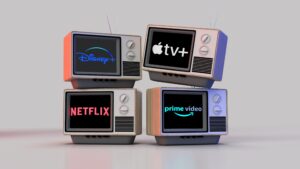May 17, 2023 / Thought Leadership
Uncovering Cracks in Connected TV
Kim Mazejka, Media Planner
Watch time for Over the Top (OTT) services has skyrocketed over the past few years as binge-streamers have declared they are here to stay.
Advertisers have been recommending investment shifts to Connected TV (CTV) for years now, and the increase in CTV ad spend over the past few years has reflected this widespread change. But what was previously a simple answer to the problem of reaching cord-cutters has become extremely fragmented over time, creating gaps in our ability to reach audiences at the scale we think we are.
While Linear can be broken down into Cable vs Broadcast, OTT can be broken down into CTV (Connected TV; anything that is streamed to a television device) and FEPs (Full Episode Players; anything streamed to a desktop, mobile, tablet, or other device). These filter down into different subscription types, (ad-free or ad-supported) as well as Free Ad Supported TV (FAST), in which a subscription is not needed to access ad-supported streaming.
The majority of larger players in the space fall under the SVOD category (Subscription Video on Demand), with most being hybrid ad-free and ad-supported these days, offering tiered paid subscriptions. AVOD (Advertising-Based Video on Demand) services, such as Fubo and Sling, only offer paid ad-supported options as these try to mirror a cable-esque experience. On the other hand, FAST are services that do not require a subscription and are more widely available.
Content differs from service to service, with more premium inventory available through higher-priced subscriptions, and audience demographics following suit; keeping in mind that more affluent audiences are more likely to pay for ad-free services.
When it comes to media buying, this gets even more complicated as we look at OEMs (Original Equipment Manufacturers) such as LG, Samsung, and most recently, Roku. These manufacturers use the data from their products and advertise to users of their TV products specifically. Partners such as Samba TV have ACR (Automatic Content Recognition) tech that we are also able to take advantage of without running directly on one type of television. Even further, we are able to run ads across DSPs (Demand-Side Platforms) utilizing ACR data, audience data from those with proprietary audience data, and run across multiple types of devices at the same time, all with real-time bidding.
So what does all of this mean for ads in the CTV landscape?
Despite the sharp increase in time spent watching CTV, and the ad spend that follows, we must take into account that about 47% of this watch time is not ad-supported. Reaching the full cord-cutter audience isn’t as simple as putting an ad on a top streaming service… if it’s even ad-supported. And with all this fragmentation, TV is no longer the mass-reach channel it once was. Understanding your audience and their media consumption behaviors, looking for incremental reach across tactics and channels, and creating a comprehensive CTV and Linear strategy is imperative to maximizing your target audience reach.
 brief us?
brief us?






